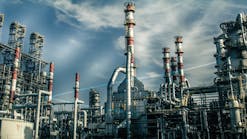Shell’s Pennsylvania chemical complex readies for 2022 commissioning
Following slowdowns in mid-March 2020 and January 2021 caused by the spreading coronavirus (COVID-19), Royal Dutch Shell PLC resumed full construction activities in first-half 2021 on subsidiary Shell Chemical Appalachia LLC’s Shell Polymers Monaca site under development just southwest of Monaca, Pa., along the Ohio River in Potter and Center Townships, Beaver County, 30 miles northwest of Pittsburgh (OGJ, Aug. 3, 2020, p. 35).
Based on the most recent timeline from Shell, the project—which will feature a dual 1.5-million tonne/year (tpy) ethylene and 1.6-million tpy polyethylene complex—remains on schedule for commissioning in 2022 (Fig. 1).
Overview
Designed to produce ethylene, high-density polyethylene (HDPE), and linear low-density polyethylene (LLDPE) from nearby supplies of Marcellus and Utica shale ethane, Shell’s Appalachian petrochemical manufacturing site will house seven tail gas and natural gas-fired ethane cracking furnaces with a heat input rating of 620 MMbtu each to support the ethane cracker and three polyethylene units, according to the latest project documents.
The complex’s two gas-phase polyethylene manufacturing lines each will be equipped to produce 550,000 tpy of either HDPE or LLDPE-grade pellets, while a third manufacturing line outfitted with INEOS AG’s slurry-loop reactor polyethylene technology will produce 500,000 tpy of HDPE pellets. Alongside installations for steam generation, storage, logistics, cooling water, and wastewater treatment, the complex also will house a 250-Mw cogeneration power unit that uses natural gas and steam to meet the site’s full electricity requirement.
Water use
The complex will recycle and reuse water in its processes, drawing about 20 million gal/day from the Ohio River. While about 80% of water used at the site will evaporate as clean steam, the rest will be treated as necessary to remove impurities and tested to ensure it meets water quality standards before supplies are returned to the river.
Water treatment measures will include:
- Recycling condensate (condensed steam from process equipment).
- Building retention ponds for storm water; water will be tested and treated as needed and then discharged to the river.
- Implementing procedures to avoid, mitigate, and quickly respond to spills before they reach water.
- Installing groundwater monitoring wells to validate protection measures are working as designed and conducting regular water-quality testing.
- Making shoreline improvements for erosion protection along the Ohio River bank adjacent to the complex.
- Enhancing and preserving in-kind habitats in the same watershed to offset impacts to wetlands and streams on the site.
Emissions controls
Already set to be equipped with the most recent (but yet-to-be-identified) technologies to maximize energy efficiency and minimize emissions, Shell said the complex also will feature secondary measures to limit emissions from the site.
These secondary measures will include:
- Recycling of tail gas—a by-product of the ethane cracking process primarily composed of clean-burning hydrogen—to power the ethane cracker furnaces.
- Undertaking other measures to eliminate visible flaring, except for flaring required during initial startup and emergency situations, such as a total regional power failure.
- Using natural gas-fired cogeneration to provide steam and electricity for the project and selling excess electricity to the grid for regional use, displacing other higher-emission sources.
- Eliminating the environmental impacts of both transporting ethane to the US Gulf Coast for processing and shipping polyethylene back to the region.
Project status
On Oct. 14, Shell Pennsylvania Chemicals confirmed via its official Facebook page the start of commissioning of the site’s cogeneration unit with steam, which over the next few days was to be followed by the beginning of steam blow activity for the complex’s ethane cracking unit.
The October commissioning activities came on the heels of Sept. 23 community inquiries regarding a sweet-smelling odor emanating from the site. In a Sept. 26 Facebook post, Shell Pennsylvania Chemicals said a thorough investigation was under way following a Sept. 24 inspection of the complex by a third-party environmental company that confirmed the odor. At the time and still early in its investigation, Shell said the odor may have been associated with passivation activities (treatments to prevent corrosion) in the cooling water tower that took place Sept. 23.
While Shell has yet to officially confirm a definitive timeline for startup of the Appalachian petrochemical complex, an updated economic impact analysis (EIA) of the project finalized by Robert Morris University professors in April 2021 and made publicly available on July 14 indicated the Shell Polymers Monaca complex is scheduled to be completed and operational by 2022 pending the absence of any state-ordered shutdowns or additional pandemic-related delays.
Commissioned by Shell, but conducted without its direct participation, the independent EIA study estimated overall cost of the project—for which Shell is receiving about $1.7 billion in Pennsylvania state corporate tax credits—has increased to at least $10 billion from its 2014 original price of $6 billion.
Midyear release of the updated EIA followed the Pennsylvania Department of Environmental Protection’s (DEP) February 2021 approval of modified air quality plans for which Shell Chemical Appalachia applied in December 2019 and February 2020. The plans were part of a request for authorization of as-built changes in design and construction of the Monaca site. Proposed changes included minor equipment additions, removal and downsizing of permitted equipment, and changes in capacities of pumping, incineration, blending, heating, storage, loading, water circulation, and flaring equipment, DEP said.
Shell, which in July 2020 completed divestment of its Appalachia oil and gas production assets—including 443,000 net leasehold acres across Pennsylvania with 358 producing wells in the Marcellus and Utica shale formations, as well as all owned and operated midstream infrastructure—has yet to reveal details regarding supply agreements with regional gas operators for the ethane required to feed the Monaca cracker project (OGJ Online, May 5, 2020).

Robert Brelsford | Downstream Editor
Robert Brelsford joined Oil & Gas Journal in October 2013 as downstream technology editor after 8 years as a crude oil price and news reporter on spot crude transactions at the US Gulf Coast, West Coast, Canadian, and Latin American markets. He holds a BA (2000) in English from Rice University and an MS (2003) in education and social policy from Northwestern University.

